Category: General
F-16 mission may be coming to Gowen starting in 2027
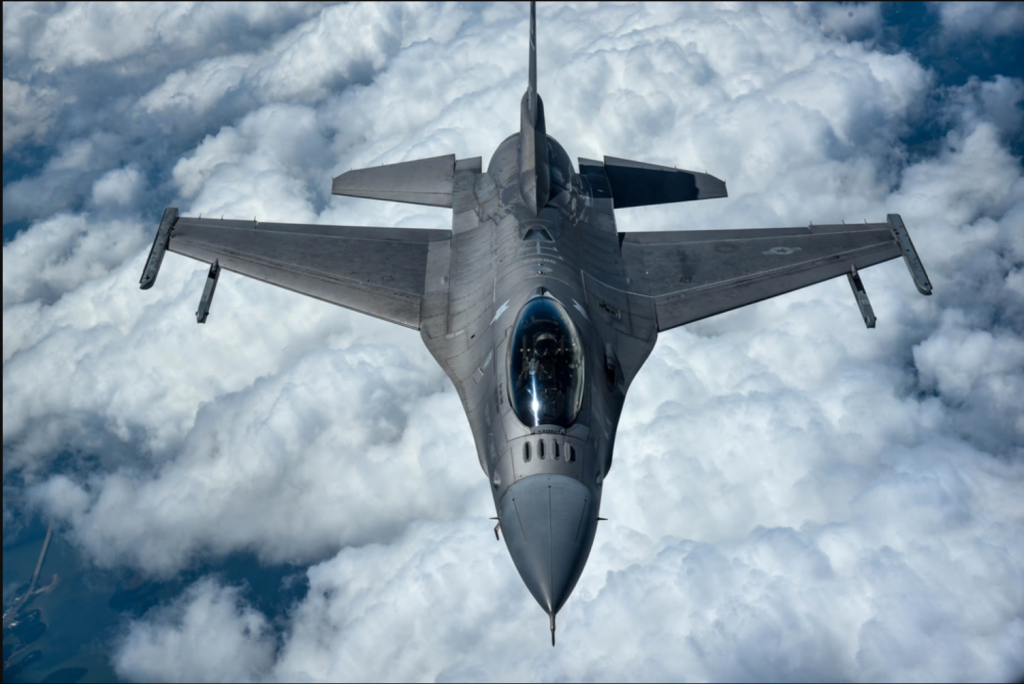
Photo by Tech. Sgt. Teri Eicher , 134th Air Refueling Wing
Gov. Brad Little and members of Idaho’s congressional delegation are proud to announce that the U.S. Air Force has identified the Idaho Air National Guard’s 124th Fighter Wing to potentially receive an F-16 Fighting Falcon mission at Gowen Field in Boise, Idaho.
F-16s are expected to begin arriving at Gowen Field in 2027.
“Idaho is proud of the critical role we have long played in supporting the nation’s defense strategy through the valuable work of the men and women serving at Gowen Field,” Gov. Little said. “The transition to the sophisticated F-16 mission at Gowen Field is the next step in the Idaho Air National Guard’s enduring commitment to safeguarding the liberties and freedoms we hold dear as Americans. This is an exciting step that will benefit the State of Idaho and the United States of America.”
The Idaho Air National Guard has maintained a fighter mission at Gowen Field for more than 75 years. This transition would replace the 18 A-10 Thunderbolt IIs that have been in service at Gowen Field since 1996. The one-for-one exchange would include the same number of F-16s, which are a more advanced and combat-effective aircraft.
The Air Force has planned to divest its aging A-10 inventory for more than a decade. Discussions have been ongoing among Idaho National Guard leaders, and local, state, and federal officials since 2012. Then, the Idaho Air National Guard was notified that their A-10 fleet was identified for divestment by 2015. However, events in Southwest Asia at the time extended the aircraft’s relevance just as the 124th FW embarked on the largest deployment in its history the following year. The 124th FW deployed again in 2020 marking its second largest deployment.
This modernization will better align the Air Force to support the current National Defense Strategy by leveraging the 124th FW’s existing fighter aircraft operations and maintenance expertise once the A-10s at Gowen Field are retired, beginning in the fall of 2026.
“Deterrence is a critical aspect of the National Defense Strategy,” said Brig. Gen. Tim Donnellan, commander of the Idaho Air National Guard. “Today’s near-peer adversaries like Russia and China remind us it’s imperative to ensure our personnel are trained and proficient with the best equipment and tools necessary to fight and win our nation’s wars.”
The Idaho National Guard expects a more detailed timeline from the Air Force in the coming months that will outline the next steps, such as the completion of an environmental impact analysis, planned for the spring of 2025.
The Idaho Air National Guard has been a fixture of the community since 1946. Since then, Idaho National Guard pilots have transitioned through 9 different types of fighter aircraft. With each new aircraft, the organization modifies its noise abatement procedures to minimize the impacts of jet noise on the community.
“Idaho National Guardsmen are rooted in every community in the state,” said Maj. Gen. Michael Garshak, adjutant general of Idaho. “When we are called upon, it’s your friends, families and neighbors coming together to support our community and our nation. Being good stewards of our environment is a priority and we will ensure Boise continues to be one of the most livable cities in the country, regardless of the aircraft we operate.”
Monday’s announcement from the Secretary of the Air Force would mean the continued viability of the Idaho National Guard. With more than $650 million dollars in annual economic impact coupled with nearly 8,000 jobs the Idaho National Guard creates, securing a follow-on fighter mission is a critical part of ensuring Idaho’s prosperity.
Program marches students toward success
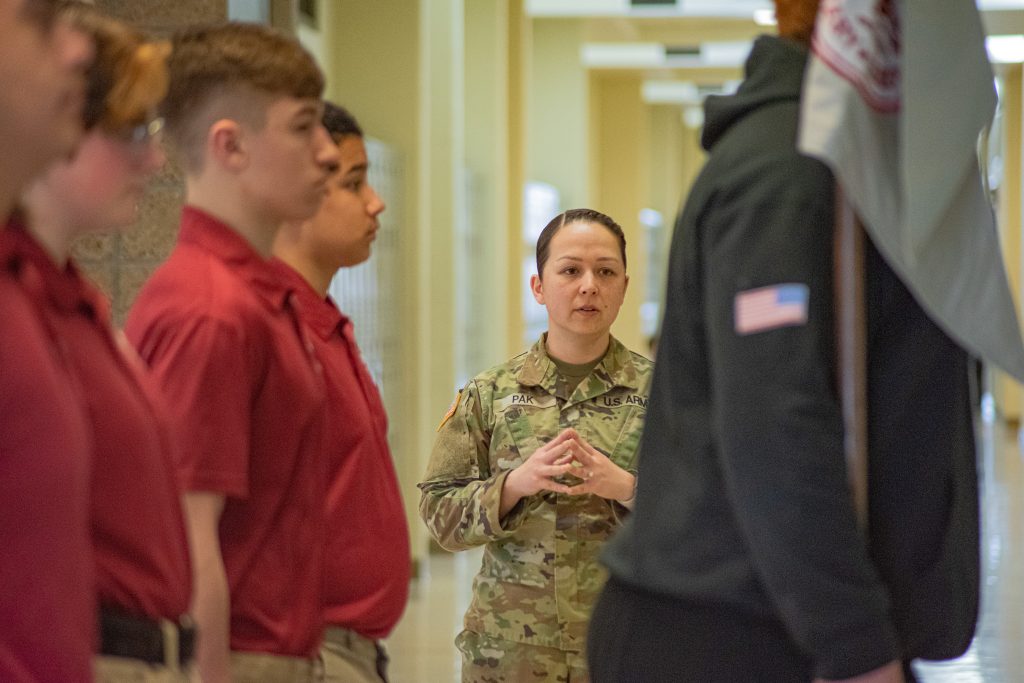
When Kadyn Edwards was a freshman, she was feeling mentally down, failing some of her classes and wanting to turn her life around. Thinking “why not?” she registered for a new class at her high school, not knowing then it would change her life.
“I started taking the class because I was going through a lot at home and school, and just wanted to make a positive change,” said Edwards. “I ended up having an awesome experience and wouldn’t have made it this far without it. Now, I’m earning straight As in all my classes and was just accepted into college.”
The 11th grader at Twin Falls High School is one of nearly 200 ninth through 12 grade students at three high schools to participate in the Idaho Army National Guard-sponsored, and school-facilitated, Military Leadership program each year.
The program offers curriculum similar to Junior ROTC without the federal funding. Like JROTC, the program teaches students about military values, leadership, teamwork, discipline, physical fitness, drill and ceremonies, customs and courtesies and more.
It also uniquely offers students opportunities to serve communities through philanthropy projects, as well as experience military training and career opportunities with Idaho Army National Guard units during drill weekends.
Instructor Staff Sgt. Sarah Pak said Edwards is one example of how the program helps students improve their high school experiences, while also preparing them for their futures. In May, Edwards will complete her third year in Military Leadership, while also graduating high school one year early. After graduation, she plans to study criminal psychology at the College of Southern Idaho.
“The stressors of school can be a lot for kids to handle,” said Pak. “They are trying to figure out who they are and evolve into confident individuals ready to embark on the rest of their lives. I’ve seen this program help so many of them find their ways, even those who aren’t interested in the military, because it gives them somewhere to belong and something to be part of.”
Previously called Military Science, the program was first introduced at Mountain Home High School approximately 20 years ago and was later offered at Twin Falls High School in 2019 and at Canyon Ridge High School in 2021. In August, the Idaho Army National Guard will expand the program to Idaho Falls High School at the request of the school and is currently working to offer the program in Pocatello and northern Idaho.
“I’ve gotten a lot of support from the Idaho Guard and school districts that have really helped me grow the program in the last few years,” said Pak. “They’ve seen the positive impact it has had, not only on students and their families, but also their communities, the economy and Idaho.”
The classes are taught by Idaho Guardsmen who serve as full-time instructors of the program and who have earned their credentialing, approved by the Idaho State Board of Education, through the Army Basic Instructor Course on Gowen Field. They also meet school district requirements, including background checks and drug testing evaluations.
Idaho’s First Female Senior Enlisted Leader Paves Way
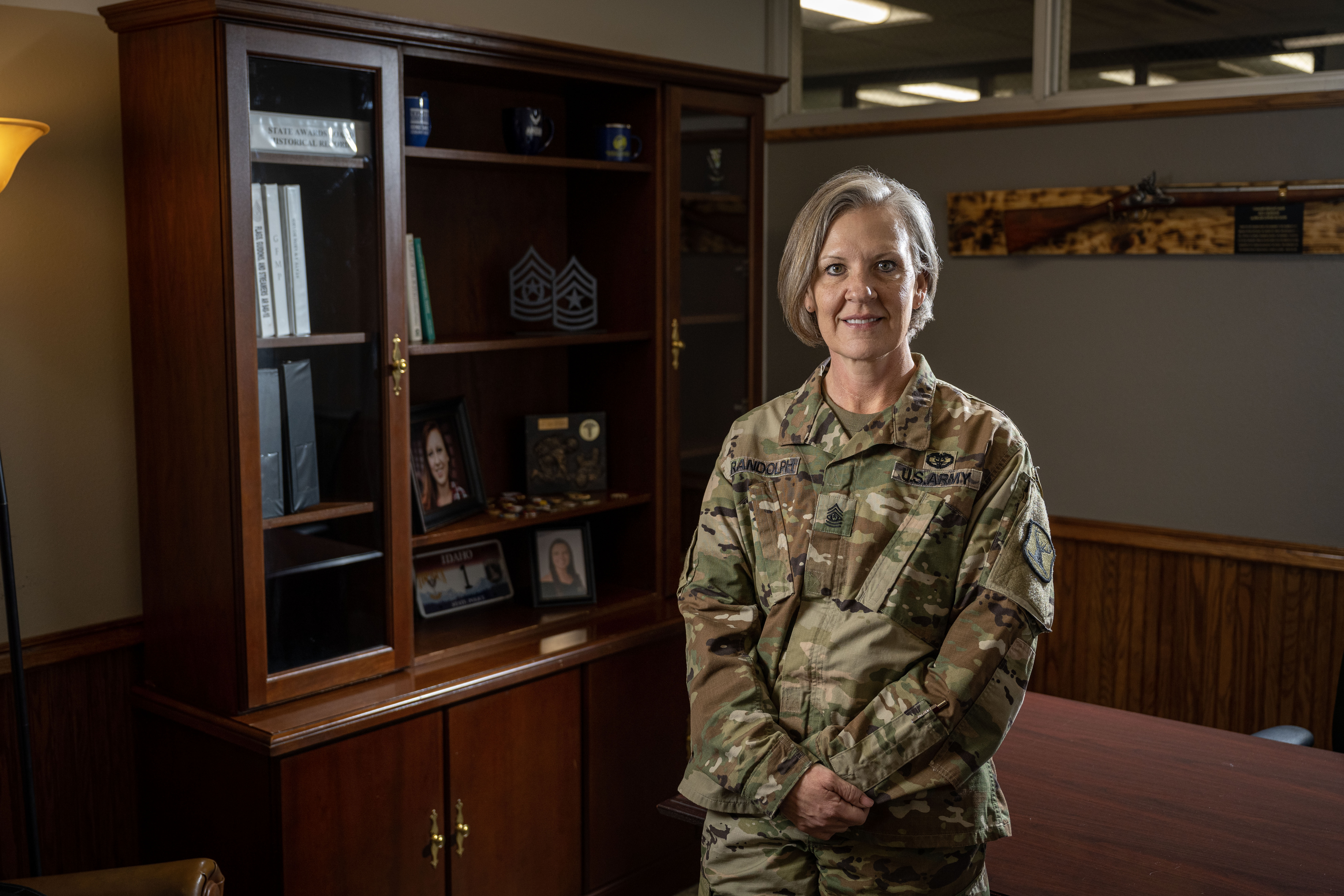
Command Sgt. Maj. Alice Randolph unofficially began her career in the U.S. Army when she was just 10 years old.
“My brother came back from basic training and taught us drill and ceremony, took us running with him and taught us inappropriate cadence,” said Randolph. “When I turned 17, neither of us hesitated when he said he was taking me to the recruiting office.”
Throughout childhood, her family home was a revolving door of foster system children. She recalls her brother, instead of playing “Simon Says,” leading “Drill Sergeant Says,” in which he’d teach her and their foster brothers and sisters cadence and facing movements.
Now, 34 years later, Randolph serves as the senior enlisted leader of the Idaho National Guard. While she chooses not to dwell on this fact, she is the first female in the organization to hold the position.
“If being the first female lets us stop talking about firsts, then that will mean something,” said Randolph. “This isn’t about me; it’s about showing Soldiers they have opportunities. I am honored to have been selected for the position based on my abilities and will do my best for the Soldiers and Airmen in our organization.”
Randolph enlisted into the Army Reserve in Nebraska as a medic in 1989. She moved to Idaho in the early 1990s to join the 116th Cavalry Brigade Combat Team’s Charlie Company, 145th Brigade Support Battalion.
She deployed to Iraq in 2004 with the company as an acting platoon sergeant. In 2010, she became the senior medical noncommissioned officer in charge of the IDARNG Medical Detachment.
Shortly after becoming Charlie Company’s first sergeant in 2014, Randolph participated in the 2015 Army’s Best Medic Competition. They were the competition’s first-ever, all-female team to participate and the Guard’s only team to compete that year.
“I’ve never striven to be in positions of higher-responsibility, only to use the positions I’d been placed in to better the organization,” said Randolph. “I would like to think I always had the organization in mind as I focused on doing my best in the position I was in at the time.”
As a part of the 116th CBCT, Randolph completed rotations at the National Training Center in 2015 as Charlie Company’s first sergeant and in 2019 as the 145th BSB’s CSM. She was Charlie Company’s first female 1SG and the battalion’s first female CSM. She was also the first female CSM to serve in the brigade.
In 2020, she served as the 204th Regional Training Institute’s command sergeant major until her selection as the IDNG’s senior enlisted leader.
As senior enlisted leader, she will serve the Idaho National Guard’s enlisted members by communicating directly with the state’s commanding general on their behalf and interpreting National Guard Bureau policy for implementation across the organization.
Though her brother left the service as her career was only beginning, his advice continues to inspire her. As an exchange student in Brazil, Randolph’s brother sent her a letter with a quote from Teddy Roosevelt. She’s held onto it and embodied it throughout her career:
“Do what you can, with what you’ve got, where you are.”
Idaho Guardsman blazes her own trail in firefighting
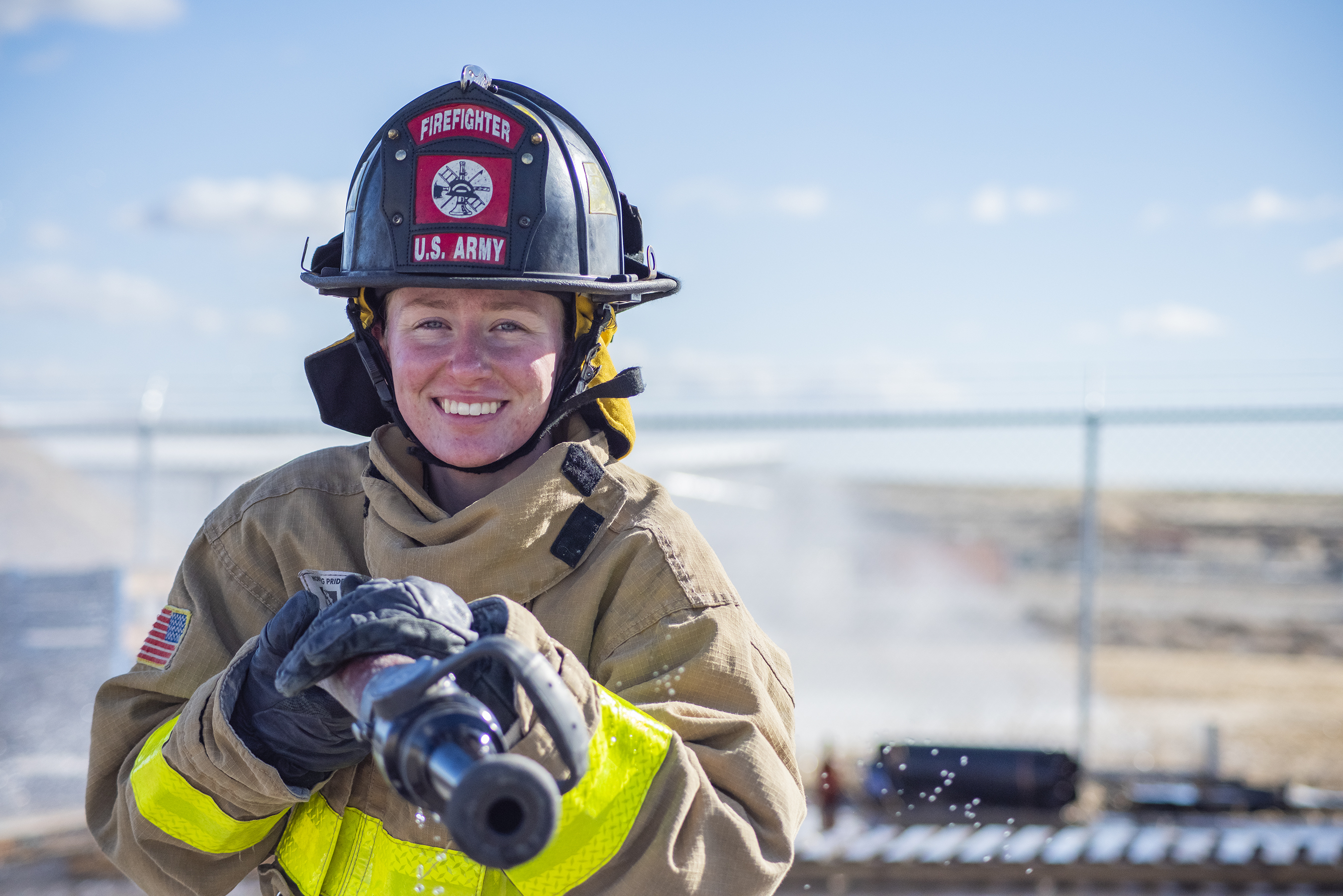
Beads of sweat dripped down her face and collected at the bottom of her mask. Her firefighting suit and breathing apparatus were heavy and weighed her down. She crawled forward and pulled the 175-pound “dummy” another 20 feet. It was her third and final drag of the fire victim removal evaluation with only minutes left to complete the task.
“I just knew in my heart that firefighting was what I was meant to do,” said Idaho Army National Guardsman Pfc. Bailey Craig. “I didn’t give myself any other choice than to get through the evaluation and, ultimately, the academy.”
The evaluation is known by students and instructors as the hardest physical part of the fire academy, especially for a small woman like Craig who is 5 feet, 6 inches tall and 130 pounds.
“I heard the academy had a high fail rate and that females don’t really make it,” said Craig. “Everyone I met up to that point said, ‘you’re not really big, the dummies are and that’s going to be tough for you.’ I went into it with the mindset that I’m going to do it because there really is no other option.”
Craig, who joined the Idaho Guard in October 2021, passed the evaluation on her first attempt. She later became a class leader and graduated from the academy in December 2022. She now serves in the Idaho Army National Guard’s 937th Engineer Detachment and is the unit’s first female to earn the 12M firefighter military occupational specialty.
“I wasn’t aware that I was the unit’s first female qualified 12M firefighter until I got back from training,” said Craig. “I hope I’m not the last one. I hope I’m the first of several. It was tough but I got here, and if I can, then other females can too.”
The 68-day academy, located at Goodfellow Air Force Base, Texas, is the only Department of Defense basic firefighting training academy in the country. During her training there, Craig learned basic firefighting fundamentals and earned certifications in airport firefighting, hazardous materials awareness, emergency medical response and more.
She said the course was fun, however, physically and mentally challenging.
“Prayer was big for me and going out there every day with a positive mindset,” said Craig. “I watched a lot of my friends fail out through the course and by the end of it, I was very used to being one of a few, if not the only, females left.”
In February, Craig attended her first training with the 937th Engineer detachment, where she met fellow Guardsman and learned to fine-tune some of the firefighting skills she picked up in the academy.
“Already after a few days at my first drill, I learned so much to help me become a better firefighter,” said Craig. “I’ve gotten a lot of hands-on training, like how to hold the fire hose nozzle a certain way for my weight. That’s a big one for me since I’m not very big myself. I’m having to learn things the way everyone else does but then tweak them a little to work for me because of my size.”
Despite her size, Craig said she became stronger in the academy, which helps her meet the physical demands of the job. Hard labor is something Craig said she is used to, having grown up working on her family’s ranch in Melba.
Born and raised in Melba, Craig spent her days working on the ranch, while also training horses, completing high school online and enjoying the outdoors.
After earning her high school diploma in 2020, Craig enrolled into the College of Western Idaho, where she is currently studying animal veterinary science. After she completes her associate’s program in May, Craig plans to study fire science and get a full-time job as a civilian firefighter.
“I’m looking forward to continuing to learn all different types of techniques in my Guard unit to help me become a better firefighter overall,” said Craig. “The guys here just know so much and are so helpful. I hope to become part of their family and a valuable member of their team, so I’m someone they can trust in any situation.”
German soldiers train with Idaho Air National Guard A-10 pilots
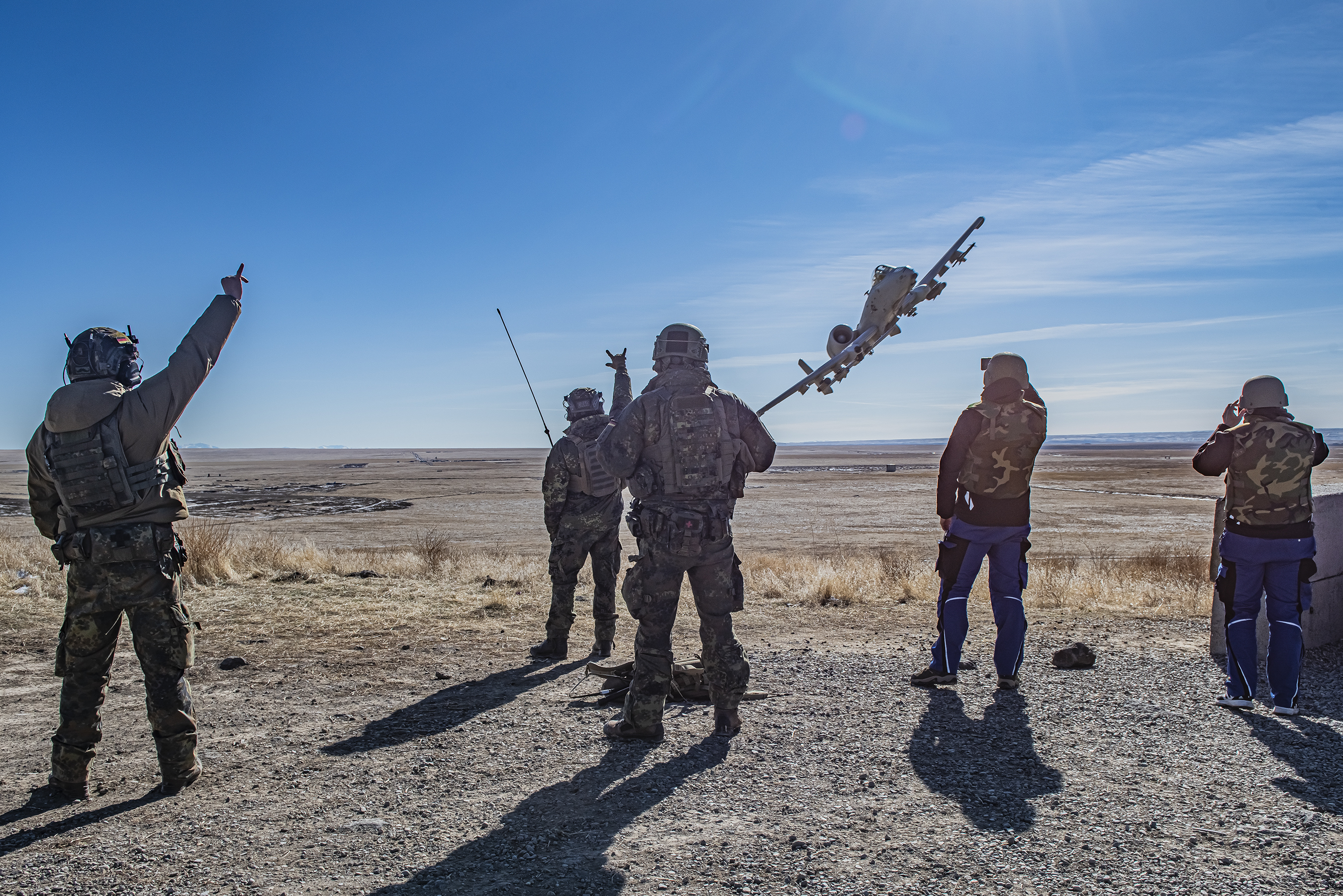
Soldiers from the German Army’s 6th Battery of the Artillery Battalion 345 joined forces with A-10 Thunderbolt II pilots assigned to the 124th Fighter Wing’s 190th Fighter Squadron Feb. 11 to 22, to conduct close air support training at Saylor Creek Range, Idaho.
“The 190th Fighter Squadron supports and encourages this training so we are prepared and familiar with our NATO counterpart’s tactics, techniques, and procedures,” said Lt. Col. Mike “Jack” Hampton, 190th Fighter Squadron commander. “The training also enables us to establish lasting relationships that we can rely on during times of war.”
The visiting soldiers from Idar-Oberstein, Germany, consisted of joint terminal attack controllers, who coordinate, integrate and direct the actions of combat aircraft engaging in close air support operations, and joint fire observers, who augment JTACs by relaying target data. The unit has trained in Idaho annually since 2016.
“The 190th accepts us here, dedicates training to us and improves our tactical training,” said a JTAC instructor from the German Army. “They honor our unit, and I am very proud in the trust that they set in us.”
The joint training between the Idaho Air National Guard and German forces incorporated NATO TTPs utilizing A-10 aircraft to prosecute targets ranging from armor, artillery, bunkers, revetments, aircraft, simulated enemy combatants, moving targets, surface to air threats and more.
“All of these target sets are incorporated into one training range, which delivers unmatched training compared to anywhere else in the world,” said Hampton. “Each training mission is complex and detailed to mirror any future conflicts in or around the European Theater but can also be used in any region of the world.”
Located approximately 43 miles southeast of Gowen Field, Saylor Creek Range offers an impact area three miles wide by six miles long, where air and ground assets can employ live munitions. A joint fires platoon sergeant with the German Army said the training site is unlike anything they have in Germany.
“In Germany, our soldiers never get into realistic situations like they do in Idaho because of training restrictions,” said the platoon sergeant. “Here you can be 500 meters away while a 2,000-pound bomb is flying off the jet. It helps our soldiers to see live munitions hit their targets because then they know what they say to pilots really matters.”
On the range, the German soldiers rehearsed various training scenarios to refine their procedures while both forces worked to hone their joint communication.
Later this year, members of the 124th Fighter Wing will deploy to Germany in support of Air Defender 2023.
One team, one fight: Army and Air join forces for mass casualty, medevac training
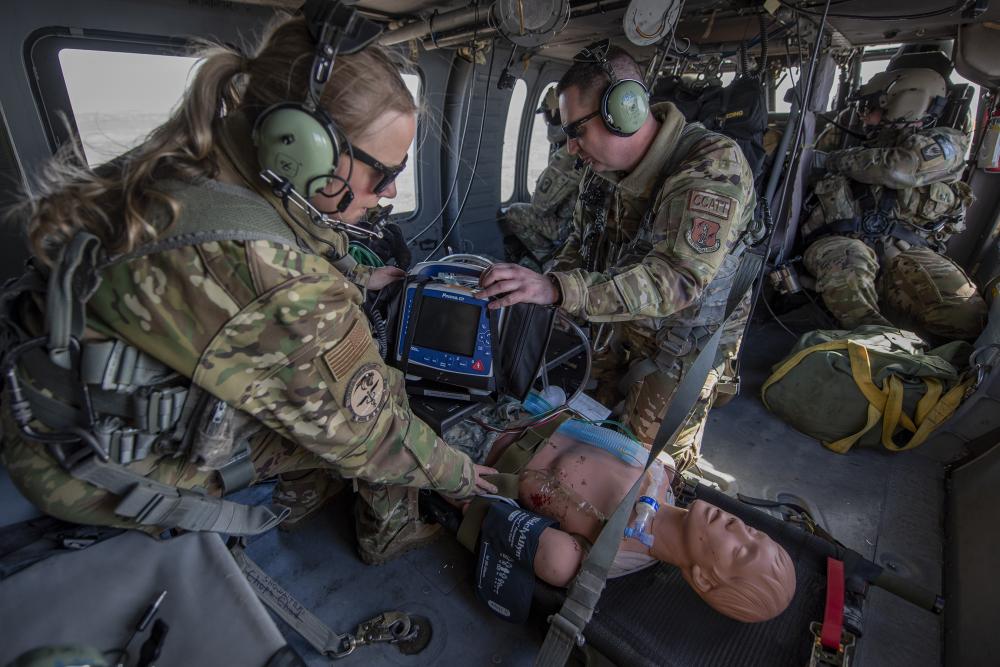
Idaho National Guard Soldiers and Airmen, as well as active duty counterparts joined forces with a one-team, one-fight mentality for joint training during a mass casualty exercise on Feb. 4 near Gowen Field.
“The best way to grow our mindset of becoming more operational and ready for a deployed environment is to train with the nearby resources, such as the Idaho Army National Guard and our active duty counterparts,” said Senior Master Sgt. Virginia Holmgren, a respiratory therapist from the Idaho Air National Guard’s 124th Medical Group. “Forming relationships with the other branches helps us to become familiar with each other’s capabilities and to practice working together because when we are in a deployed environment we will be working with the other branches in the fight.”
Medical personnel from Gowen Field’s 124th Medical Group and active duty medical personnel with the 366th Medical Group from Mountain Home Air Force Base teamed up for several mass casualty events, which also included the use of medevac Soldiers and UH-60 Black Hawk helicopters from the Idaho Army National Guard’s 1st of the 168th Aviation Regiment to participate in the medical evacuation scenarios.
“This exercise is a great example of how the Idaho National Guard is committed to the joint warfighting doctrine in support of the National Defense Strategy,” said Brig. Gen. Tim Donnellan, Idaho Air National Guard commander. “The 124th Medical Group coordinated this incredible training using combat proven units from the Idaho Army National Guard, the Idaho Air National Guard, and the Gunfighters of the 366th Fighter Wing.”
During the scenarios, combat medics performed treatment and stabilized casualties at a field medical tent in a simulated deployed location. The focus for the combat medics during the mass casualty scenarios was an emphasis on Tactical Combat Casualty Care. The TCCC is the military guideline for trauma life support in pre-hospital combat medicine, designed to reduce preventable deaths while continuing to maintain operation success.
“With our new DoD guidelines for the TCCC, it requires us to have more hands-on deck and for more Airmen to be familiar with trauma care in responding to worse injuries out on the field rather than the typical self aid and buddy care that we have focused on in the past,” said Senior Master Sgt. Davis Nguyen, the 124th Medical Group Function Area Manager.
Once medics respond and stabilize casualties, they could then recognize the patients that needed more advanced critical care at a hospital outside of the combat field location and the 9-Line medevac call requesting the Black Hawk medevac team was made. In combat, the 9-Line is an emergency medevac request with an accurate report of combat injuries that is often the difference between life and death.
The ground combat medics and the Black Hawk flight medics worked together to stabilize the casualty during flight until they reached the simulated higher echelon of medical care.
Additional scenarios required protective gear to be worn during a chemical, biological, radiological or nuclear event while Idaho National Guard Soldiers conducted hoist rescue training, allowing Airmen the chance to gain insight into a full range of rescue capabilities of the medevac Soldiers.
“I am proud of the commitment of the men and women in this joint, total force exercise demonstrating the incredible talent and the first class training capabilities we have here in Idaho,” said Donnellan. “We will continue to maintain our readiness for the immediate fight while preparing for any conflicts of the future.”
U.S. Navy Sailors assigned to the USS IDAHO submarine visit Idaho
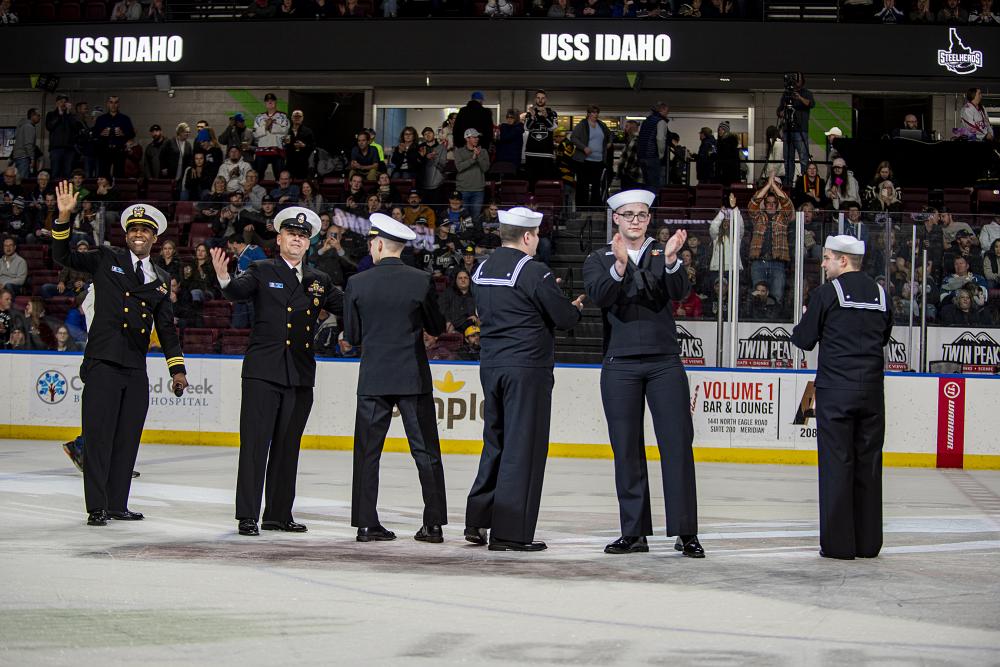
Idahoans from across the state welcomed a contingent of the first U.S. Navy Sailors assigned to the USS IDAHO SSN 799 nuclear powered attack submarine. The USS Idaho Commissioning Committee sponsored the six Sailors’ weeklong tour during the last week in January to the Gem State to encourage them to become familiar with all things Idaho.
Idahoans welcomed Lt. Commander Darrell Smith, Master Chief Petty Officer Travis Skipper, Lt. Beckett Lemley, Machinist Mate 1st Class Justin Teal, Information Technology 2nd Class Peyton Freck and Machinist Mate 3rd Class Gianni Luzzetti across the state.
The Idaho Steelheads recognized the six crewmembers out on the ice during Wednesday’s hockey game and Idahoans got a chance to meet the Sailors at the McCall Winter Carnival. The Sailors spent some time on Gowen Field and met with the Idaho National Guard leadership. Additionally, the crew visited with the late Medal of Honor recipient Art Jackson’s wife Sally Jackson; visited the Idaho State Veterans Cemetery; toured the Idaho Veterans Garden in Caldwell; spoke at school assemblies; attended the USS IDAHO Night at the Boise State University basketball game; visited Idaho Legislature and were introduced to a session of the Idaho State Senate and much more throughout the week.
The purpose of the visit to Idaho is to familiarize the Sailors with the state of Idaho and to establish a bond between Idaho’s citizens and the Sailors who will take the USS IDAHO to sea as a crucial part of the nation’s military strategy.
The future USS IDAHO is a leading-edge Virginia Class nuclear-powered fast attack submarine currently being built by General Dynamics Electric Boat in Connecticut. According to the USS Idaho Commissioning Committee the submarine will be christened this fall and commissioned into the Navy fleet in the fall of 2024.
A small Idaho town makes a big Veteran’s Day impression
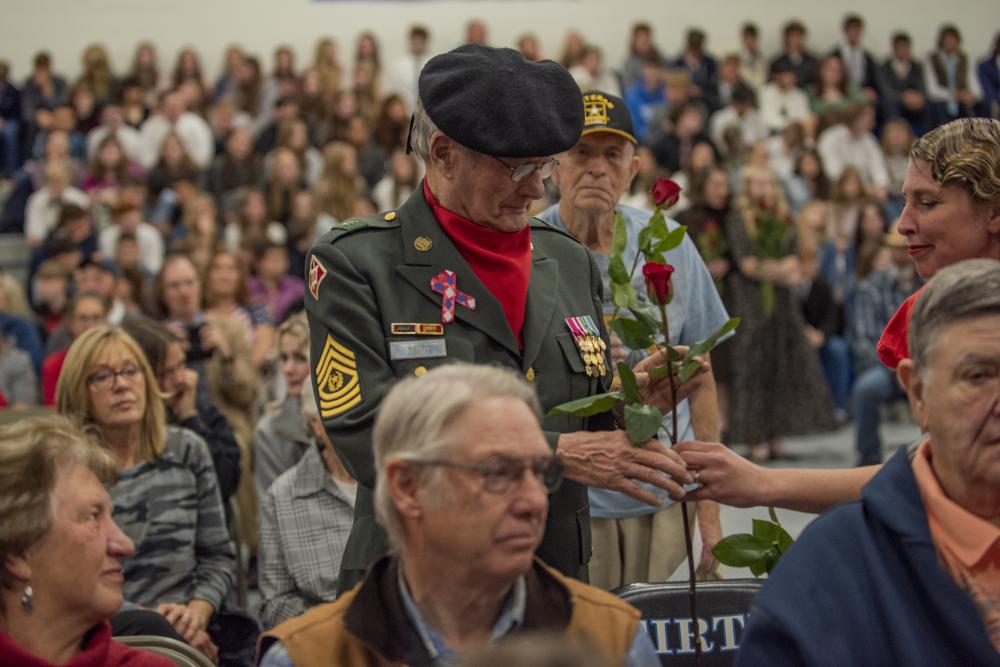
The rural town of Firth held a large Veteran’s Day assembly in Eastern Idaho on Nov. 10th, inviting hundreds of attendees, including Idaho’s adjutant general, Maj. Gen. Michael Garshak.
The assembly honored more than 100 local veterans and their families with help from more than 600 local and surrounding town volunteers, students, teachers and administrators. The assembly was held at Firth High School. The population of the small town is just shy of 600 people, according to the latest United States Census Bureau.
Four Soldiers from the Idaho National Guard’s 148th Field Artillery Regiment posted the flags. Local veterans of all branches and current service members were recognized at the assembly and presented with plaques and roses. Garshak spoke at the assembly about the importance of patriotism.
“Those of us in the military in Idaho are fortunate to serve in a state that truly honors and appreciates military service, and nowhere more so than here in Eastern Idaho,” said Garshak.
He continued. “While Veteran’s Day is an opportunity to thank those who have sacrificed, especially during times of war, where the survival of our nation has hung in the balance, it is also an opportunity to recognize and appreciate the value military service brings to our state, our country and to those who serve.”
Garshak thanked every veteran, past and present, and future veterans, for their service to our nation. He thanked the crowd for their support as well on behalf of the Idaho National Guard and the U.S. military.
Garshak closed his remarks with the takeaway that military service is not all about sacrifice.
“Yes, there are times when it is hard, but that comes with all walks of life,” he said. “I’ve learned that the things we value the most, and bring the greatest reward, are the things that we have worked the hardest for.”
Idaho Soldiers return home from overseas deployment
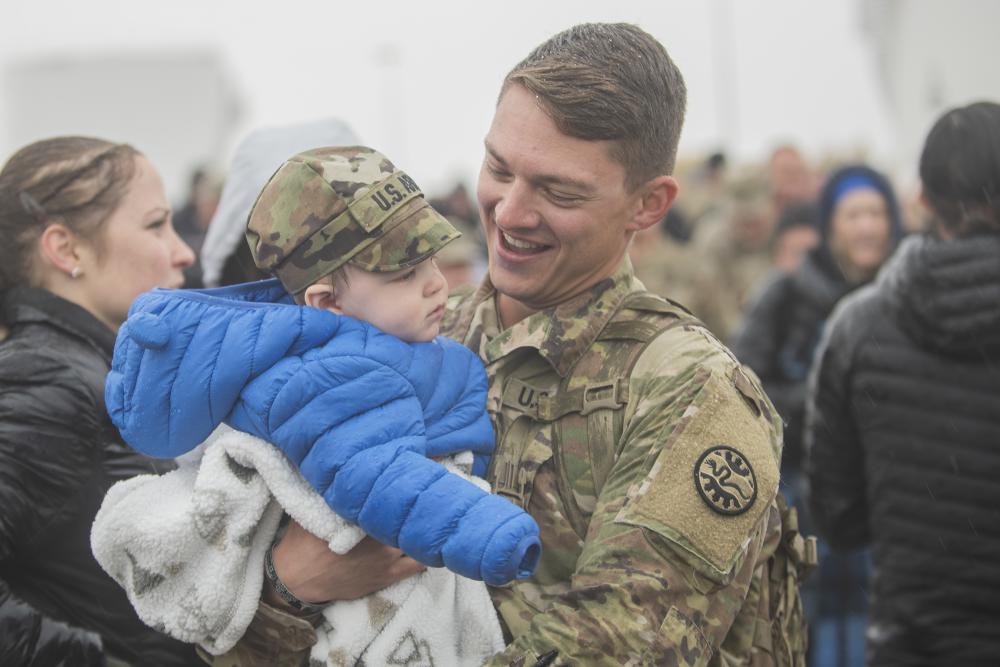
The Idaho Army National Guard welcomed home to Boise, Idaho, nearly 100 116th Cavalry Brigade Combat Team Soldiers on Nov. 4th after a yearlong deployment to Southwest Asia in support of Operation Spartan Shield. An additional 100 other Soldiers returned to their communities elsewhere across the state throughout the day.
“These Soldiers embody what the National Guard is all about: citizen-Soldiers who serve their nation when called upon and return home to their families and communities,” said Brig. Gen. Farin Schwartz, commander, Idaho Army National Guard. “It’s an honor to welcome these Soldiers home and I thank each one of them for their service and dedication to our state and nation. For 10 months, our Soldiers deterred enemy aggression in a very hostile environment, symbolizing our nation’s commitment to our global partners and allies.”
The Soldiers deployed in November 2021 to support the 116th Cavalry Brigade Combat Team’s Task Force Griz, which was headquartered by the Montana Army National Guard and included Soldiers from the Idaho, Montana, Florida and Nevada Army National Guards.
Idaho Soldiers comprised nearly 20 percent of the task force, which spent 10 months overseas, in addition to receiving 45 days of training stateside before deploying.
OSS is a joint mission under the United States Central Command and is part of Operation Enduring Freedom. The task force provided three mission response forces to the CENTCOM commander and conducted missions and training exercises in Iraq, Jordan, the Kingdom of Saudi Arabia, Kuwait, Syria and Qatar.
The task force conducted security and stability operations and demonstrated the U.S.’s continued commitment to deterring adversaries while supporting regional allies. The task force was relieved in October by another 116th CBCT-led task force, including more than 600 Idaho Soldiers, who are expected to return next year.
Task Force Griz Soldiers began returning to Fort Bliss, Texas, Oct. 24 and conducted demobilization activities before returning home.
The 116th CBCT previously deployed in support of the Global War on Terror in 2004 and 2010 to Iraq.
Boise firefighters train Idaho’s Civil Support Team on rope rescue
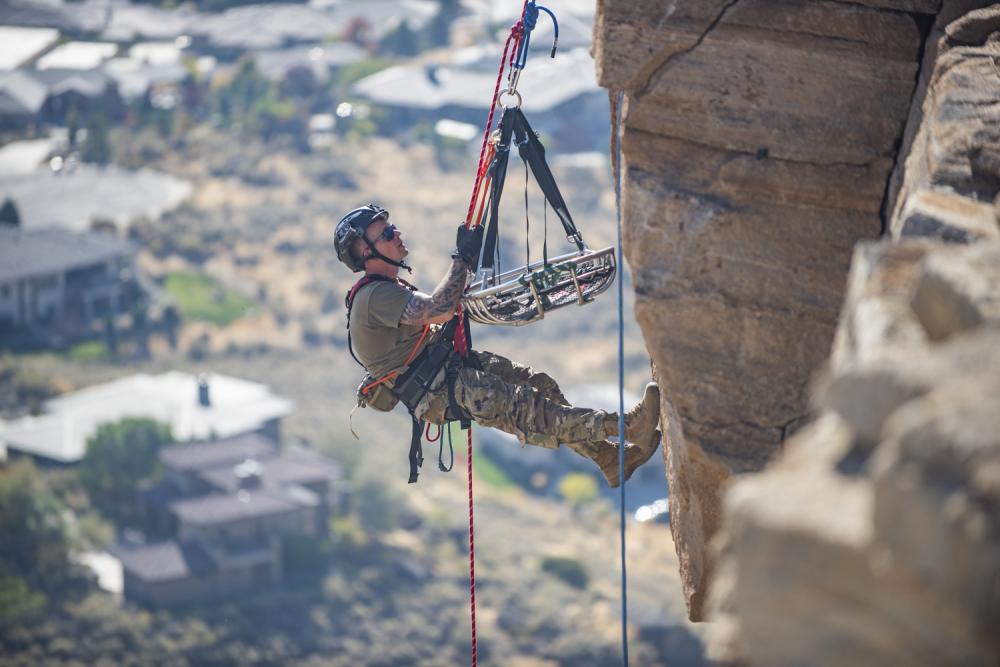
Throughout the month of October, the Idaho National Guard’s 101st Civil Support Team partnered with the Boise Fire Department Technical Rescue Team to participate in a ropes rescue course taught by Boise firefighters. The course, which served as an annual recertification for the CST Guardsmen, entailed two weeklong sessions for the 22-member team and helped the Boise firefighters refine their skills as trainers.
“This training benefits both the Idaho National Guard and us,” said Brent Matthews, captain of the Boise Technical Rescue Team. “Not only are we certifying our partners on ropes rescue training, but our instructors also get valuable experience and more proficient as certifiable instructors.”
The first week, Oct. 10th through the 14th, started with the classroom portion of learning about ropes rescue as a prerequisite for the hands-on portion of the training. Using what they learned about the ropes, the CST Guardsmen rappelled from tops of buildings at the Boise Fire Department’s Fire Training Center.
Once the Guardsmen were proficient at ropes rappelling, they practiced ropes rescues using wire rescue baskets at cliffs near the Table Rock trails in the Boise foothills to simulate a large-scale rescue of multiple people.
“To utilize the CST in ropes rescue, there would be an instance where something serious happened like a natural or man-made disaster or an emergency where the local search and rescue team wouldn’t have enough resources and could call us,” said Lt. Col. Robert Grimes, 101st CST commander.
The second weeklong training, Oct. 24th through 28th, focused on confined space rescues at Boise’s Lucky Peak Power Plant. The training mirrored a scenario where a devastated occurrence or a large-scaled catastrophe, like an earthquake, happened with severe damage to a building that could involve chemicals. This would require HAZMAT precautions, along with a large number of rescues in buildings with confined spaces, and would involve ropes and sked stretchers.
These incidents could be intensified by a lack of oxygen that is available in a non-ventilated area and complicated by the tight confines of the space, requiring rescuers to have air tanks during a rescue.
“Confined space is a rescue of people, for instance, inside of a building, in a tunnel or inside tanks where there could be a HAZMAT situation. They might be injured too badly to get out on their own or they could be unconscious,” said Grimes. “The CST has the capability to respond to weapons of mass destruction and HAZMAT scenarios already. The ropes rescue and confined space training adds another capability for the CST to assist the local fire departments and local agencies.”
The Boise Fire Department Technical Rescue Team is highly trained to handle the emergencies involving ropes rescues and confined space rescues, however, they could call upon their 101st CST partners if the large number of rescues surpassed their limit.
“We’ve been building this relationship and working together for quite a while,” said Matthews. “The CST has really great HAZMAT capabilities. Having the CST already trained at HAZMAT, plus the ropes rescue and confined space training, benefits us as well. In the future, I’d like to see us integrate more in real-world situations. When we have a HAZMAT call with confined spaces, we can call them to assist. I can see us working really closely together in the future.”
 Official Government Website
Official Government Website